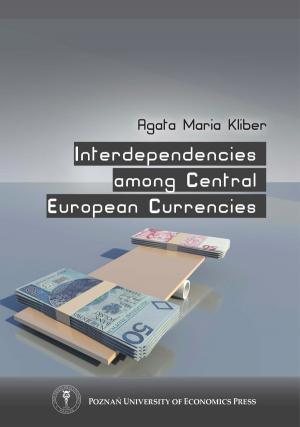
e-ISBN:
Edition: I
Publication date: 2010
First publication date: 2010
Pages: 104
Print: paperback
Electronic version:
Format: B5
License : commercial
last week: 10
last 3 months: 86
Agata Kliber
Interdependencies among Central European Currencies
 Interdependencies among Central European Curencies
Interdependencies among Central European Curencies
Availability and purchase
Kliber, A. (2010). Interdependencies among Central European Currencies. Poznań University of Economics and Business Press.
In the book the author investigates relationships among three Central European currencies: Czech crown, Hungarian forint and Polish zloty over the period of 1 O years. Based upon the relationships the strength of linkages among the Central European economies is measured and ił is checked whether they broke up or - on contrary - became even stronger during the 2008/2009 financial crisis. Ił is also verified whether the currencies in Central Europe can infect themselves with crises or is ił rather the influence of the euro area that plays the prominent role.
In order to measure the strength of the relationships among the currencies, the author concentrates on the exchange rates volatility and its spillovers. The methods of volatility modeling are presented and the concepts of volatility transmission and financial contagion are discussed.
The book may be of interest to investors on the foreign exchange market, authorities dealing with monetary policy, as well as students of disciplines connected with financial econometrics or financial engineering.
Introduction
1. Exchange rate regimes
2. Volatility
2.1. Concept and models
2.2. ARCH and GARCH models
2.3. Univariate Stochastic Volatility models
2.3.1. The base Stochastic Volatility Model
2.3.2. Stochastic Volatility Model with Student distribution
2.3.3. Stochastic Volatility Model with Leverage Effect
2.4. Multivariate Stochastic Volatility models
2.4.1. Dynamic Conditional Correlation Stochastic Volatility Model (DCC-MSV)
2.4.2. Stochastic Volatility Model with Granger Causality (GC-MSV)
3. Volatility transmission – a survey
3.1. The basic concepts
3.2. Methodology
3.2.1. Tests based upon the reactions to unexpected shocks or news – the volatility spillover index
3.2.2. Tests on structural breaks in correlation
3.2.3. Causality tests
4. The data
4.1. Raw data
4.2. Logarithmic differences
5. Volatility estimation
5.1. Volatility of CZK/USD exchange rate
5.2. Volatility of HUF/USD exchange rate
5.3. Volatility of PLN/USD exchange rate
5.4. Volatility of EUR/USD exchange rate
6. Volatility transmission – spillovers effect
6.1. Volatility transmission over the whole period – the method of covariance matrix decomposition
6.1.1. Regional volatility transmission
6.1.2. Transmission between Western and Central Europe exchange markets 47
6.2. Index of volatility spillover
7. Volatility transmission – correlation effect
7.1. Changes in dynamic correlation between Central Europe and Euro Zone
7.1.1. CZK/USD and EUR/USD
7.1.2. HUF/USD and EUR/USD
7.1.3. PLN/USD and EUR/USD
7.2. Changes in dynamic correlation within the Central European Market
7.2.1. CZK/USD and HUF/USD
7.2.2. CZK/USD and PLN/USD
7.2.3. HUF/USD and PLN/USD
8. Volatility transmission – the causality effect
8.1. Causality between CZK/USD and HUF/USD
8.1.1. Order of variables: CZK/USD – HUF/USD
8.1.2. Order of variables: HUF/USD – CZK/USD
8.2. Causality between HUF/USD and PLN/USD
8.2.1. Order of variables: HUF/USD – PLN/USD
8.2.2. Order of variables: PLN/USD – HUF/USD
8.3. Causality between CZK/USD and PLN/USD
8.3.1. Ordering of variables: CZK/USD – PLN/USD
8.3.2. Ordering of variables: PLN/USD – CZK/USD
8.4. Causality between CZK/USD and EUR/USD
8.5. Causality between PLN/USD and EUR/USD
8.6. Causality between HUF/USD and EUR/USD
Conclusions
References
Index of tables
Index of figures
Streszczenie


